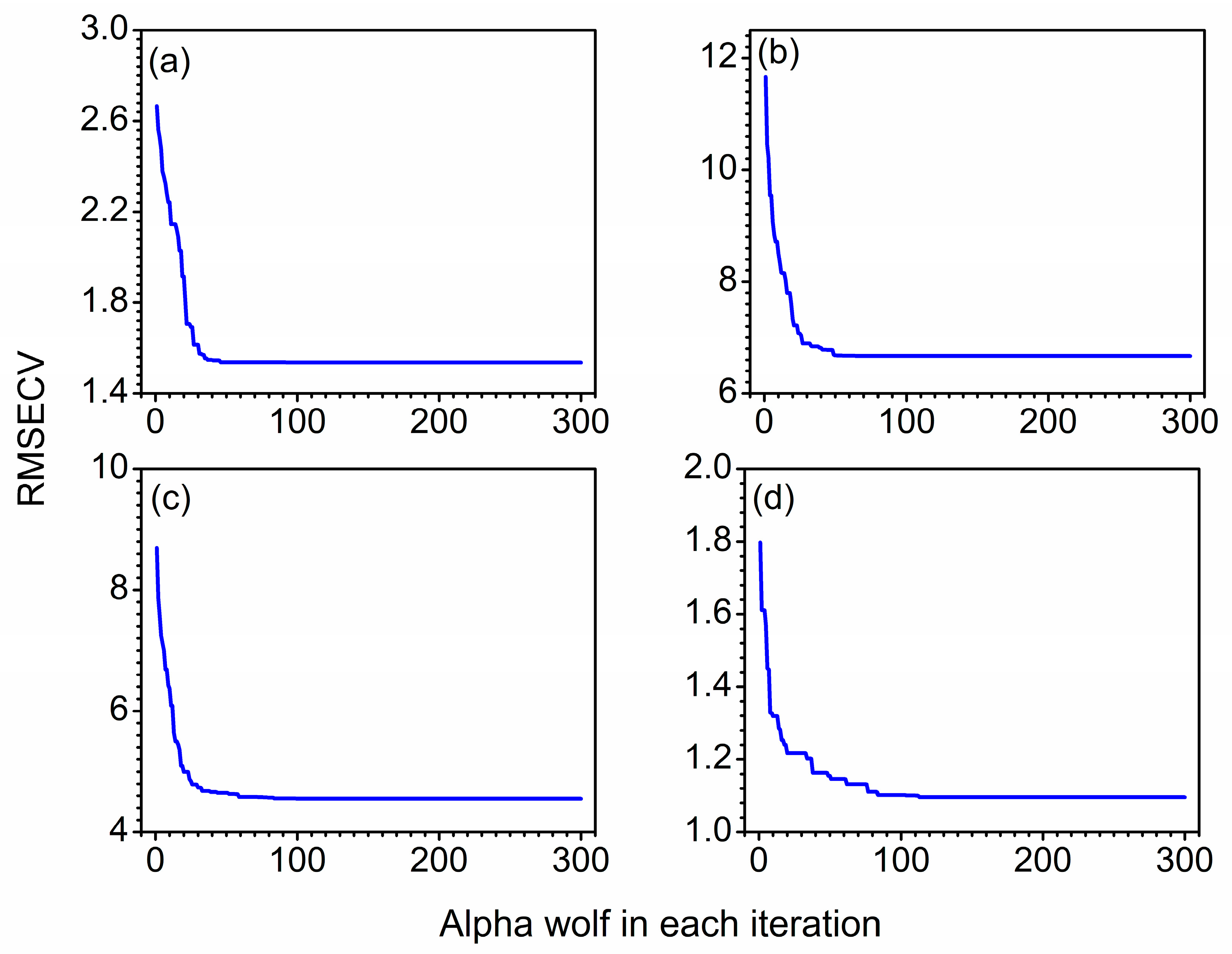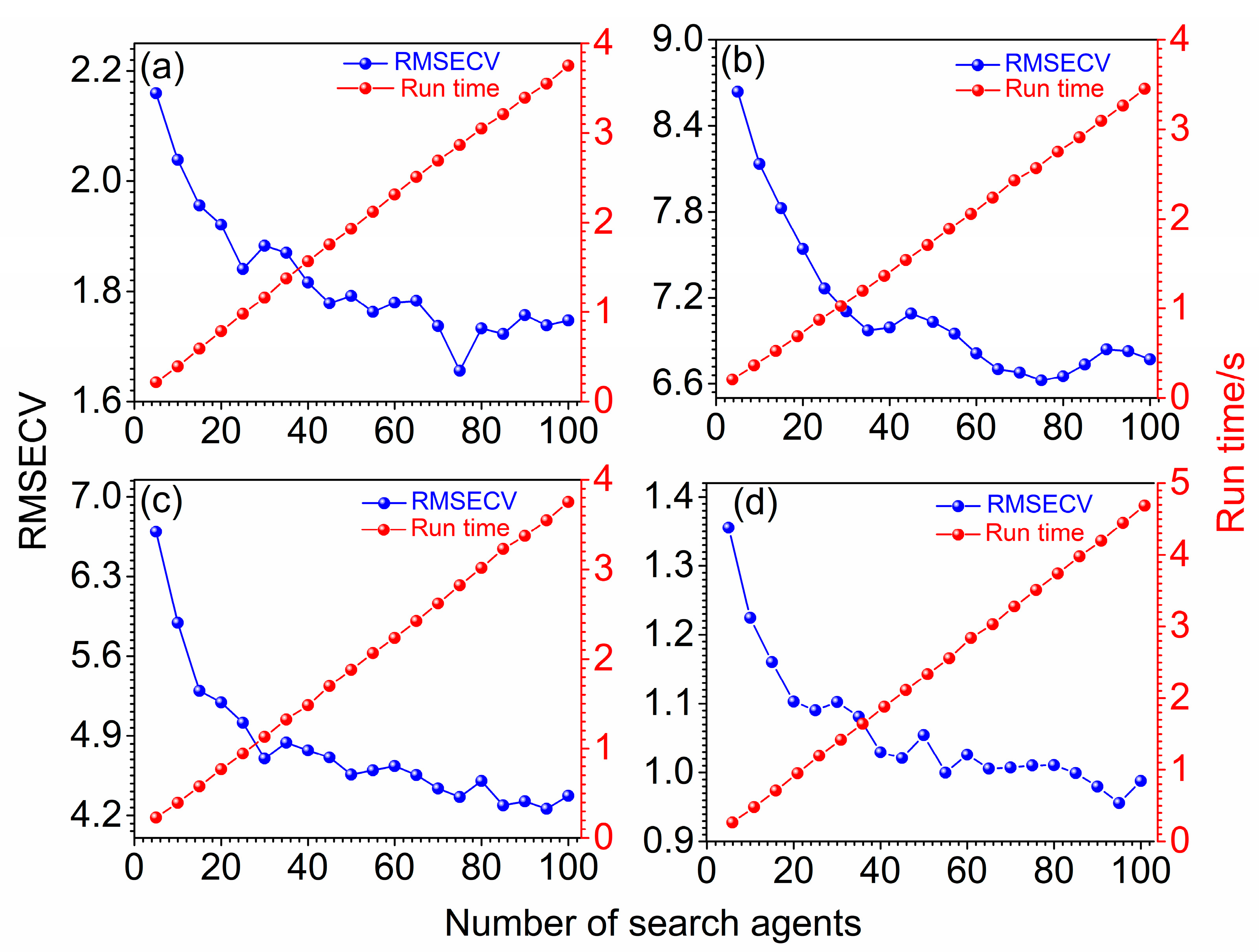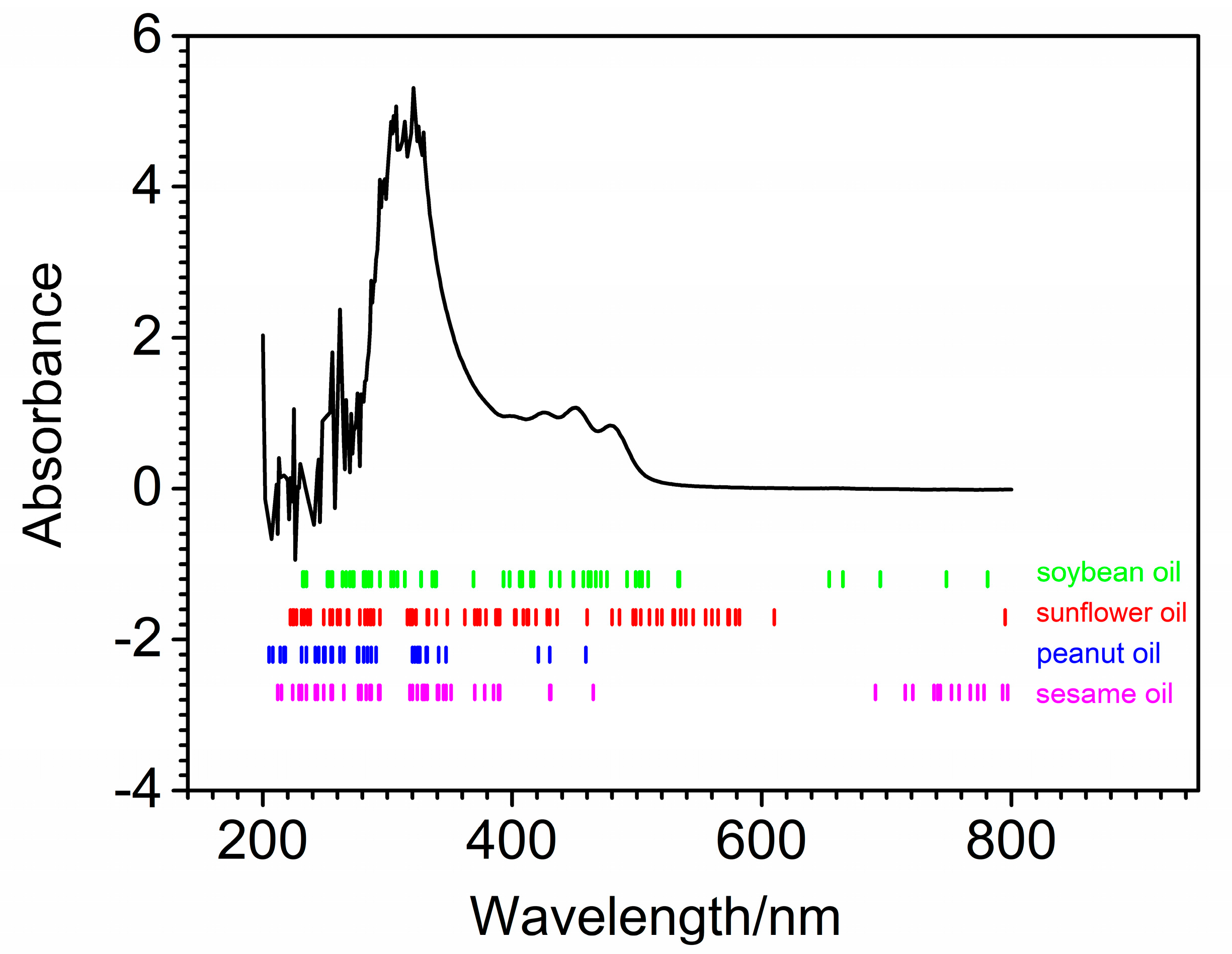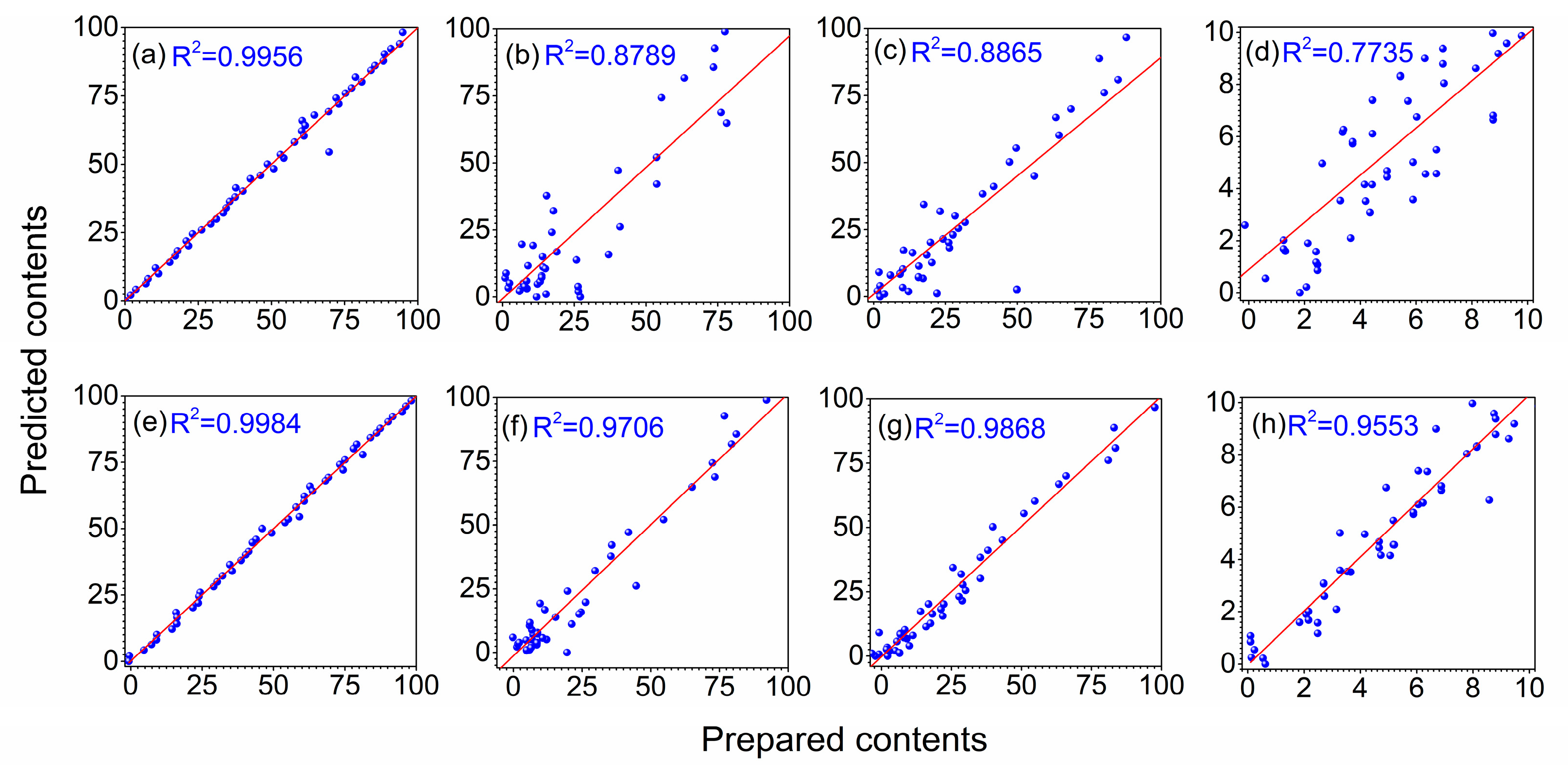Grey Wolf Optimizer for Variable Selection in Quantification of Quaternary Edible Blend Oil by Ultraviolet-Visible Spectroscopy
Abstract
:1. Introduction
2. Materials and Methods
2.1. Materials and Apparatus
2.2. Sample Preparation
2.3. Spectral Measurements
2.4. Chemometric Tools and Evaluation
2.4.1. Grey Wolf Optimizer
2.4.2. A Discretized GWO-PLS for Variable Selection
2.4.3. Quantitative Analysis and Model Evaluation
3. Results and Discussion
3.1. The Performance of Wolves
3.2. Determination of the Iteration Number
3.3. Optimization of the Wolf Number
3.4. Prediction Results
4. Conclusions
Author Contributions
Funding
Institutional Review Board Statement
Informed Consent Statement
Data Availability Statement
Conflicts of Interest
Sample Availability
References
- Rohman, A. The use of infrared spectroscopy in combination with chemometrics for quality control and authentication of edible fats and oils: A review. Appl. Spectrosc. Rev. 2017, 52, 589–604. [Google Scholar] [CrossRef]
- Ilic, M.; Pastor, K.; Romanic, R.; Vujic, D.; Acanski, M. A new challenge in food authenticity: Application of a novel mathematical model for rapid quantification of vegetable oil blends by Gas Chromatography-Mass Spectrometry (GC-MS). Anal. Lett. 2022. [Google Scholar] [CrossRef]
- Goncalves, R.P.; Marco, P.H.; Valderrama, P. Thermal edible oil evaluation by UV-Vis spectroscopy and chemometrics. Food Chem. 2014, 163, 83–86. [Google Scholar] [CrossRef] [PubMed]
- Xing, C.R.; Yuan, X.Y.; Wu, X.Y.; Shao, X.L.; Yuan, J.; Yan, W.J. Chemometric classification and quantification of sesame oil adulterated with other vegetable oils based on fatty acids composition by gas chromatography. LWT-Food Sci. Technol. 2019, 108, 437–445. [Google Scholar] [CrossRef]
- Zhang, H.; Hu, X.Y.; Liu, L.M.; Wei, J.F.; Bian, X.H. Near infrared spectroscopy combined with chemometrics for quantitative analysis of corn oil in edible blend oil. Spectroc. Acta Pt. A-Molec. Biomolec. Spectr. 2022, 270, 120841. [Google Scholar] [CrossRef] [PubMed]
- Jimenez-Carvelo, A.M.; Gonzalez-Casado, A.; Cuadros-Rodriguez, L. A new analytical method for quantification of olive and palm oil in blends with other vegetable edible oils based on the chromatographic fingerprints from the methyl-transesterified fraction. Talanta 2017, 164, 540–547. [Google Scholar] [CrossRef]
- Han, J.X.; Sun, R.X.; Zeng, X.Y.; Zhang, J.K.; Xing, R.R.; Sun, C.D.; Chen, Y. Rapid classification and quantification of camellia (Camellia oleifera Abel.) oil blended with rapeseed oil using FTIR-ATR spectroscopy. Molecules 2020, 25, 2036. [Google Scholar] [CrossRef] [PubMed]
- Dong, W.; Zhang, Y.Q.; Zhang, B.; Wang, X.P. Rapid prediction of fatty acid composition of vegetable oil by Raman spectroscopy coupled with least squares support vector machines. J. Raman Spectrosc. 2013, 44, 1739–1745. [Google Scholar] [CrossRef]
- Shimamoto, G.G.; Tubino, M. Alternative methods to quantify biodiesel in standard diesel-biodiesel blends and samples adulterated with vegetable oil through UV-Visible spectroscopy. Fuel 2016, 186, 199–203. [Google Scholar] [CrossRef]
- Wu, X.Y.; Bian, X.H.; Lin, E.; Wang, H.T.; Guo, Y.G.; Tan, X.Y. Weighted multiscale support vector regression for fast quantification of vegetable oils in edible blend oil by ultraviolet-visible spectroscopy. Food Chem. 2021, 342, 128245. [Google Scholar] [CrossRef]
- Li, L.N.; Liu, X.F.; Yang, F.; Xu, W.M.; Wang, J.Y.; Shu, R. A review of artificial neural network based chemometrics applied in laser-induced breakdown spectroscopy analysis. Spectroc. Acta Pt. B-Atom. Spectr. 2021, 180, 106183. [Google Scholar] [CrossRef]
- Hernandez, N.; Talavera, I.; Biscay, R.J.; Porro, D.; Ferreira, M.M.C. Support vector regression for functional data in multivariate calibration problems. Anal. Chim. Acta 2009, 642, 110–116. [Google Scholar] [CrossRef]
- Bian, X.H.; Li, S.J.; Fan, M.R.; Guo, Y.G.; Chang, N.; Wang, J.J. Spectral quantitative analysis of complex samples based on the extreme learning machine. Anal. Methods 2016, 8, 4674–4679. [Google Scholar] [CrossRef]
- Chang, C.W.; Laird, D.A.; Mausbach, M.J.; Hurburgh, C.R. Near-infrared reflectance spectroscopy-principal components regression analyses of soil properties. Soil Sci. Soc. Am. J. 2001, 65, 480–490. [Google Scholar] [CrossRef]
- Jiao, T.H.; Hassan, M.M.; Zhu, J.J.; Ali, S.; Ahmad, W.; Wang, J.J.; Lv, C.X.; Chen, Q.S.; Li, H.H. Quantification of deltamethrin residues in wheat by Ag@ZnO NFs-based surface-enhanced Raman spectroscopy coupling chemometric models. Food Chem. 2021, 337, 127652. [Google Scholar] [CrossRef]
- Zou, X.B.; Zhao, J.W.; Povey, M.J.W.; Holmes, M.; Mao, H.P. Variables selection methods in near-infrared spectroscopy. Anal. Chim. Acta 2010, 667, 14–32. [Google Scholar]
- Gomes, A.D.; Alcaraz, M.R.; Goicoechea, H.C.; Araujo, M.C.U. The Successive Projections Algorithm for interval selection in trilinear partial least-squares with residual bilinearization. Anal. Chim. Acta 2014, 811, 13–22. [Google Scholar] [CrossRef]
- Li, Y.; Wang, G.Z.; Guo, G.S.; Li, Y.X.; Via, B.K.; Pei, Z.Y. Spectral pre-processing and multivariate calibration methods for the prediction of wood density in chinese white poplar by visible and near infrared spectroscopy. Forests 2022, 13, 62. [Google Scholar] [CrossRef]
- Araujo, M.C.U.; Saldanha, T.C.B.; Galvao, R.K.H.; Yoneyama, T.; Chame, H.C.; Visani, V. The successive projections algorithm for variable selection in spectroscopic multicomponent analysis. Chemom. Intell. Lab. Syst. 2001, 57, 65–73. [Google Scholar] [CrossRef]
- Li, H.D.; Liang, Y.Z.; Xu, Q.S.; Cao, D.S. Key wavelengths screening using competitive adaptive reweighted sampling method for multivariate calibration. Anal. Chim. Acta 2009, 648, 77–84. [Google Scholar] [CrossRef]
- Koshoubu, J.; Iwata, T.; Minami, S. Elimination of the uninformative calibration sample subset in the modified UVE (uninformative variable elimination)-PLS (partial least squares) method. Anal. Sci. 2001, 17, 319–322. [Google Scholar] [CrossRef]
- Cai, W.S.; Li, Y.K.; Shao, X.G. A variable selection method based on uninformative variable elimination for multivariate calibration of near-infrared spectra, Chemometrics Intell. Lab. Syst. 2008, 90, 188–194. [Google Scholar] [CrossRef]
- Bian, X.H.; Zhang, R.L.; Wang, J.; Liu, P.; Lin, L.G.; Tan, X.Y. Rapid quantification of adulterated Panax notoginseng powder by ultraviolet-visible diffuse reflectance spectroscopy combined with chemometrics. Chin. J. Anal. Chem. 2022, 50, 100055. [Google Scholar] [CrossRef]
- Xu, H.; Liu, Z.C.; Cai, W.S.; Shao, X.G. A wavelength selection method based on randomization test for near-infrared spectral analysis. Chemom. Intell. Lab. Syst. 2009, 97, 189–193. [Google Scholar] [CrossRef]
- Goodarzi, M.; Coelho, L.D. Firefly as a novel swarm intelligence variable selection method in spectroscopy. Anal. Chim. Acta 2014, 852, 20–27. [Google Scholar] [CrossRef]
- Mirjalili, S.; Mirjalili, S.M.; Lewis, A. Grey wolf optimizer. Adv. Eng. Softw. 2014, 69, 46–61. [Google Scholar] [CrossRef]
- Gao, Q.; Wang, P.; Niu, T.; He, D.J.; Wang, M.L.; Yang, H.J.; Zhao, X.Q. Soluble solid content and firmness index assessment and maturity discrimination of Malus micromalus Makino based on near-infrared hyperspectral imaging. Food Chem. 2022, 370, 131013. [Google Scholar] [CrossRef]
- Daniel, E.; Anitha, J.; Kamaleshwaran, K.K.; Rani, I. Optimum spectrum mask based medical image fusion using gray wolf optimization. Biomed. Signal Process. Control 2017, 34, 36–43. [Google Scholar] [CrossRef]
- Komaki, G.M.; Kayvanfar, V. Grey wolf optimizer algorithm for the two-stage assembly flow shop scheduling problem with release time. J. Comput. Sci. 2015, 8, 109–120. [Google Scholar] [CrossRef]
- Lu, C.; Gao, L.; Li, X.Y.; Xiao, S.Q. A hybrid multi-objective grey wolf optimizer for dynamic scheduling in a real-world welding industry. Eng. Appl. Artif. Intell. 2017, 57, 61–79. [Google Scholar] [CrossRef]
- Mosavi, A.; Samadianfard, S.; Darbandi, S.; Nabipour, N.; Qasem, S.N.; Salwana, E.; Band, S.S. Predicting soil electrical conductivity using multi-layer perceptron integrated with grey wolf optimizer. J. Geochem. Explor. 2021, 220, 106639. [Google Scholar] [CrossRef]
- Chanda, S.; Sing, D.; Majumder, S.; Nag, S.; Karmakar, S.; Upadhyay, A.K.; Hazarik, A.K.; Sabhapondit, S.; Tasrin, S. NIR spectroscopy with grey wolf optimization algorithm for prediction of polyphenol content in inward tea leaves. In Proceedings of the IEEE Calcutta Conference, Kolkata, India, 2–3 December 2017. [Google Scholar]
- Malik, A.; Tikhamarine, Y.; Souag-Gamane, D.; Rai, P.; Sammen, S.S.; Kisi, O. Support vector regression integrated with novel meta-heuristic algorithms for meteorological drought prediction. Meteorol. Atmos. Phys. 2021, 133, 891–909. [Google Scholar] [CrossRef]
- Gupta, S.; Deep, K. A novel random walk grey wolf optimizer. Swarm Evol. Comput. 2019, 44, 101–112. [Google Scholar] [CrossRef]
- Long, W.; Cai, S.H.; Jiao, J.J.; Tang, M.Z. An efficient and robust grey wolf optimizer algorithm for large-scale numerical optimization. Soft Comput. 2020, 24, 997–1026. [Google Scholar] [CrossRef]
- Liu, P.; Wang, J.; Li, Q.; Gao, J.; Tan, X.Y.; Bian, X.H. Rapid identification and quantification of Panax notoginseng with its adulterants by near infrared spectroscopy combined with chemometrics. Spectroc. Acta Pt. A-Molec. Biomolec. Spectr. 2019, 206, 23–30. [Google Scholar] [CrossRef] [PubMed]







| Components | Training Set | Prediction Set | ||||||
|---|---|---|---|---|---|---|---|---|
| Number | Range (%) | Mean (%) | S.D. (%) | Number | Range (%) | Mean (%) | S.D. (%) | |
| Soybean oil | 51 | 0.0000–100.0000 | 50.0475 | 29.4469 | 51 | 0.0000–100.0000 | 50.0464 | 29.3892 |
| Sunflower oil | 51 | 0.0000–98.9873 | 21.0154 | 27.0065 | 51 | 0.0000–98.9790 | 21.0174 | 27.1036 |
| Peanut oil | 51 | 0.0000–96.6313 | 23.9602 | 25.6240 | 51 | 0.0000–96.6733 | 23.9459 | 25.5380 |
| Sesame oil | 51 | 0.0000–10.1021 | 4.9777 | 2.9918 | 51 | 0.0000–11.3495 | 4.9895 | 3.0449 |
| Components | Methods | Number of Variables a | RMSEP (S.D.) b | R2 (S.D.) c |
|---|---|---|---|---|
| Soybean oil | PLS | 601 | 2.7821 (0) | 0.9955 (0) |
| MCUVE-PLS | 383 (100–520) | 2.6181 (0.0424) | 0.9960 (0.0001) | |
| RT-PLS | 235 (40–530) | 2.5243 (0.0617) | 0.9963 (0.0002) | |
| GWO-PLS | 70 (50–100) | 1.7845 (0.1867) | 0.9981 (0.0004) | |
| Sunflower oil | PLS | 601 | 12.9824 (0) | 0.8789 (0) |
| MCUVE-PLS | 125 (110–160) | 10.9133 (0.0887) | 0.9173 (0.0011) | |
| RT-PLS | 111 (110–120) | 10.7287 (0.2436) | 0.9222 (0.0050) | |
| GWO-PLS | 78 (43–107) | 6.8456 (0.2935) | 0.9678 (0.0029) | |
| Peanut oil | PLS | 601 | 12.3936 (0) | 0.8865 (0) |
| MCUVE-PLS | 88 (60–140) | 9.2418 (0.4848) | 0.9335 (0.0072) | |
| RT-PLS | 80 (50–150) | 10.5005 (0.2259) | 0.9155 (0.0038) | |
| GWO-PLS | 64 (34–96) | 4.3657 (0.2824) | 0.9854 (0.0020) | |
| Sesame oil | PLS | 601 | 2.0009 (0) | 0.7734 (0) |
| MCUVE-PLS | 76 (60–340) | 1.8964 (0.0192) | 0.7880 (0.0049) | |
| RT-PLS | 282 (40–540) | 1.9693 (0.0151) | 0.7839 (0.0094) | |
| GWO-PLS | 75 (51–124) | 0.9642 (0.0542) | 0.9502 (0.0061) |
Publisher’s Note: MDPI stays neutral with regard to jurisdictional claims in published maps and institutional affiliations. |
© 2022 by the authors. Licensee MDPI, Basel, Switzerland. This article is an open access article distributed under the terms and conditions of the Creative Commons Attribution (CC BY) license (https://creativecommons.org/licenses/by/4.0/).
Share and Cite
Zhang, R.; Wu, X.; Chen, Y.; Xiang, Y.; Liu, D.; Bian, X. Grey Wolf Optimizer for Variable Selection in Quantification of Quaternary Edible Blend Oil by Ultraviolet-Visible Spectroscopy. Molecules 2022, 27, 5141. https://doi.org/10.3390/molecules27165141
Zhang R, Wu X, Chen Y, Xiang Y, Liu D, Bian X. Grey Wolf Optimizer for Variable Selection in Quantification of Quaternary Edible Blend Oil by Ultraviolet-Visible Spectroscopy. Molecules. 2022; 27(16):5141. https://doi.org/10.3390/molecules27165141
Chicago/Turabian StyleZhang, Rongling, Xinyan Wu, Yujie Chen, Yang Xiang, Dan Liu, and Xihui Bian. 2022. "Grey Wolf Optimizer for Variable Selection in Quantification of Quaternary Edible Blend Oil by Ultraviolet-Visible Spectroscopy" Molecules 27, no. 16: 5141. https://doi.org/10.3390/molecules27165141







